2019 | OriginalPaper | Buchkapitel
Attention Assessment: Evaluation of Facial Expressions of Children with Autism Spectrum Disorder
verfasst von : Bilikis Banire, Dena Al Thani, Mustapha Makki, Marwa Qaraqe, Kruthika Anand, Olcay Connor, Kamran Khowaja, Bilal Mansoor
Erschienen in: Universal Access in Human-Computer Interaction. Multimodality and Assistive Environments
Aktivieren Sie unsere intelligente Suche, um passende Fachinhalte oder Patente zu finden.
Wählen Sie Textabschnitte aus um mit Künstlicher Intelligenz passenden Patente zu finden. powered by
Markieren Sie Textabschnitte, um KI-gestützt weitere passende Inhalte zu finden. powered by
